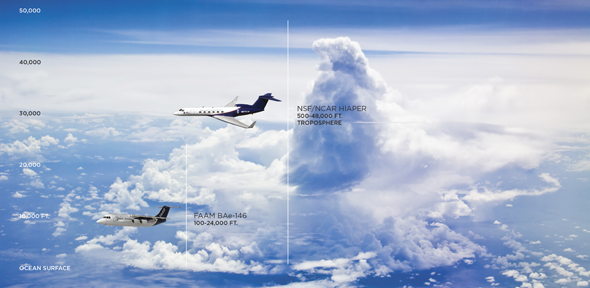Clik here to view.

While efforts to limit emissions of greenhouse gases, including ozone, tend to focus on industrial activities and the burning of fossil fuels, a new study suggests that future regulations may need to address the burning of forests and vegetation. The study, published in the journal Nature Communications, indicates that ‘biomass burning’ may play a larger role in climate change than previously realised.
Based on observations from two aircraft missions, satellite data and a variety of models, an international research team showed that fires burning in tropical Africa and Southeast Asia caused pockets of high ozone and low water in the lower atmosphere above Guam – a remote island in the Pacific Ocean 1,700 miles east of Taiwan.
“We were very surprised to find high concentrations of ozone and chemicals that we know are only emitted by fires in the air around Guam,” said the study’s lead author Daniel Anderson, a graduate student at the University of Maryland. “We didn’t make specific flights to target high-ozone areas – they were so omnipresent that no matter where we flew, we found them.”
For the study, two research planes on complementary missions flew over Guam measuring the levels of dozens of chemicals in the atmosphere in January and February 2014. One aircraft flew up to 24,000 feet above the ocean surface during the UK Natural Environment Research Council’s Coordinated Airborne Studies in the Tropics (CAST) mission. The other flew up to 48,000 feet above the ocean surface during the CONvective Transport of Active Species in the Tropics (CONTRAST) mission.
Image may be NSFW.
Clik here to view.
“International collaboration is essential for studying global environmental issues these days,” said CAST Principal Investigator Neil Harris, of Cambridge’s Department of Chemistry. “This US/UK-led campaign over the western Pacific was the first of its kind in this region and collected a unique data set. The measurements are now starting to produce insight into how the composition of the remote tropical atmosphere is affected by human activities occurring nearly halfway around the world.”
Researchers examined 17 CAST and 11 CONTRAST flights and compiled over 3,000 samples from high-ozone, low-water air parcels for the study. In the samples, the team detected high concentrations of chemicals associated with biomass burning—hydrogen cyanide, acetonitrile, benzene and ethyne.
“Hydrogen cyanide and acetonitrile were the smoking guns because they are emitted almost exclusively by biomass burning. High levels of the other chemicals simply added further weight to the findings,” said study co-author Julie Nicely, a graduate student from the University of Maryland.
Next, the researchers traced the polluted air parcels backward 10 days, using the National Oceanic and Atmospheric Administration (NOAA) Hybrid Single Particle Lagrangian Integrated Trajectory (HYSPLIT) model and precipitation data, to determine where they came from. Overlaying fire data from NASA’s moderate resolution imaging spectroradiometer (MODIS) on board the Terra satellite, the researchers connected nearly all of the high-ozone, low-water structures to tropical regions with active biomass burning in tropical Africa and Southeast Asia.
“The investigation utilised a variety of models, including the NCAR CAM-Chem model to forecast and later analyse chemical and dynamical conditions near Guam, as well as satellite data from numerous instruments that augmented the interpretation of the aircraft observations,” said study co-author Douglas Kinnison, a project scientist at the University Corporation for Atmospheric Research.
In the paper, the researchers also offer a new explanation for the dry nature of the polluted air parcels.
“Our results challenge the explanation atmospheric scientists commonly offer for pockets of high ozone and low water: that these zones result from the air having descended from the stratosphere where air is colder and dryer than elsewhere,” said University of Maryland Professor Ross Salawitch, the study’s senior author and principal investigator of CONTRAST.
“We know that the polluted air did not mix with air in the stratosphere to dry out because we found combined elevated levels of carbon monoxide, nitric oxide and ozone in our air samples, but air in the higher stratosphere does not contain much naturally occurring carbon monoxide,” said Anderson.
The researchers found that the polluted air that reached Guam never entered the stratosphere and instead simply dried out during its descent within the lower atmosphere. While textbooks show air moving upward in the tropics, according to Salawitch, this represents the net motion of air. Because this upward motion happens mostly within small storm systems, it must be balanced by air slowly descending, such as with these polluted parcels released from fires.
Based on the results of this study, global climate models may need to be reassessed to include and correctly represent the impacts of biomass burning, deforestation and reforestation, according to Salawitch. Also, future studies such as NASA’s upcoming Atmospheric Tomography Mission will add to the data collected by CAST and CONTRAST to help obtain a clearer picture of our changing environment.
In addition to those mentioned above, the study’s authors included UMD Department of Atmospheric and Oceanic Science Professor Russell Dickerson and Assistant Research Professor Timothy Canty; CAST co-principal investigator James Lee of the University of York; CONTRAST co-principal investigator Elliott Atlas of the University of Miami; and additional researchers from NASA; NOAA; the University of California, Irvine; the California Institute of Technology; the University of Manchester; the Institute of Physical Chemistry Rocasolano; and the National Research Council in Argentina.
This research was supported by the Natural Environment Research Council, National Science Foundation, NASA, and National Oceanic and Atmospheric Administration.
Reference:
Daniel C. Anderson et al. ‘A pervasive role for biomass burning in tropical high ozone/low water structures’ Nature Communications (2016). DOI: 10.1038/ncomms10267.
Inset image: Air Tracking. Credit: Daniel Anderson
Adapted from a University of Maryland press release.
Study indicates ‘biomass burning’ may play a larger role in climate change than previously realised.
Image may be NSFW.
Clik here to view.
The text in this work is licensed under a Creative Commons Attribution 4.0 International License. For image use please see separate credits above.